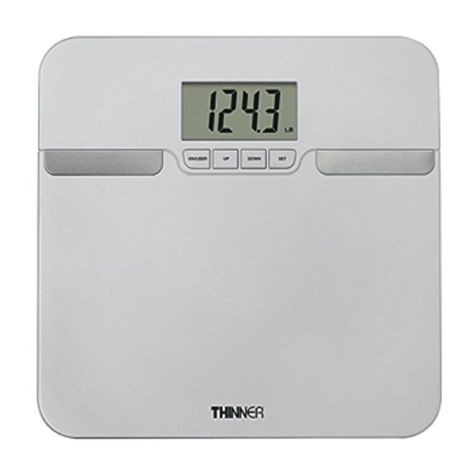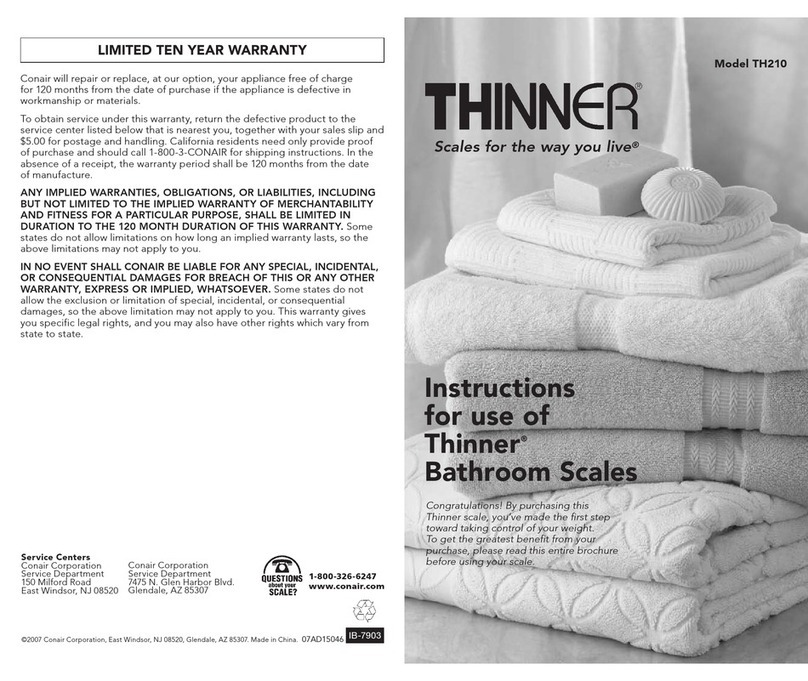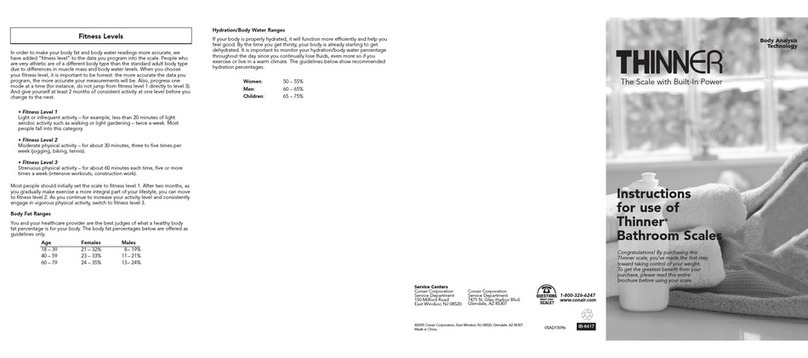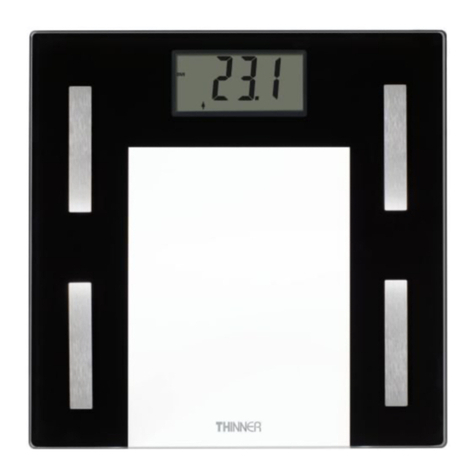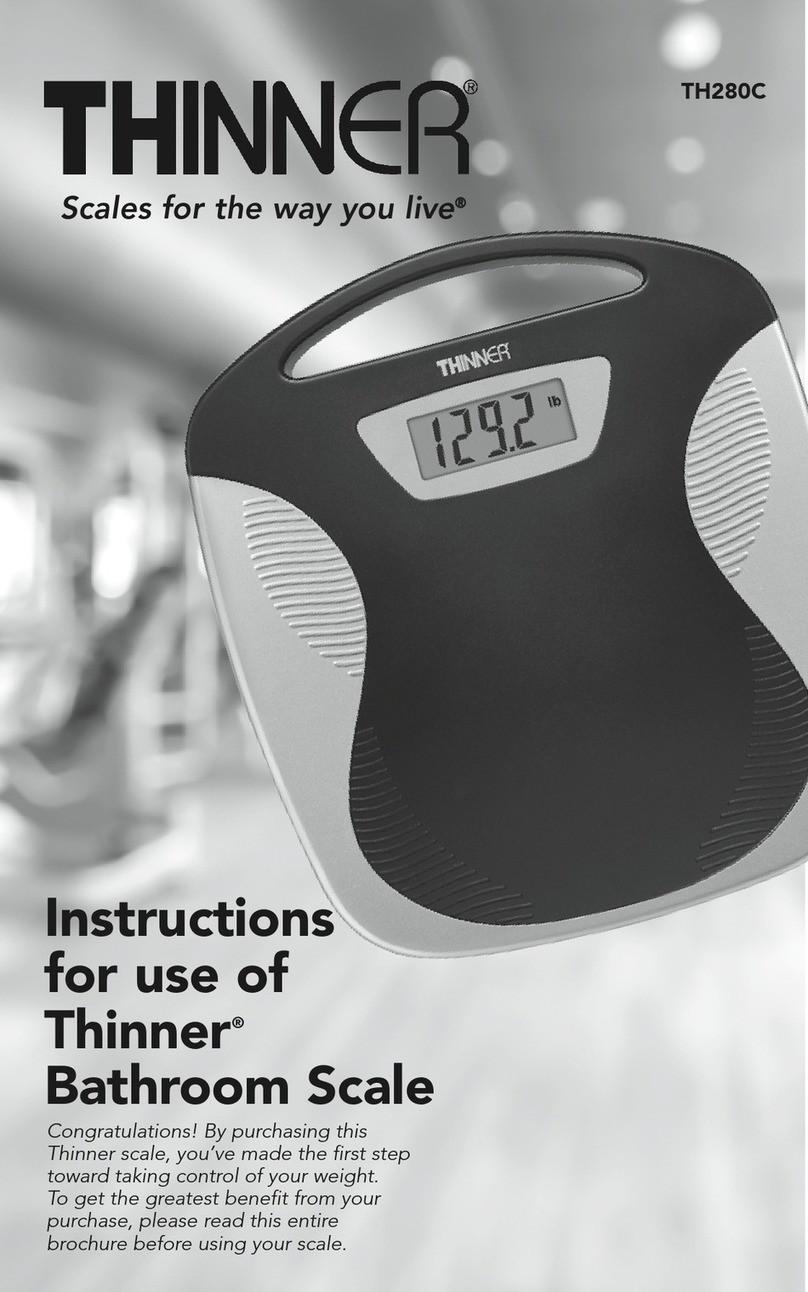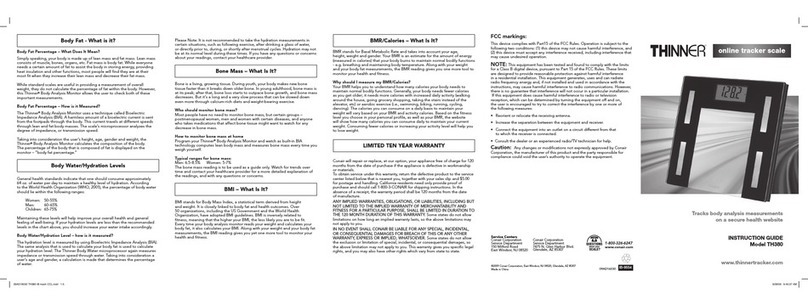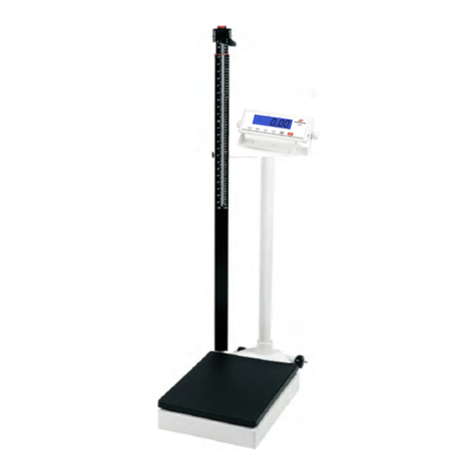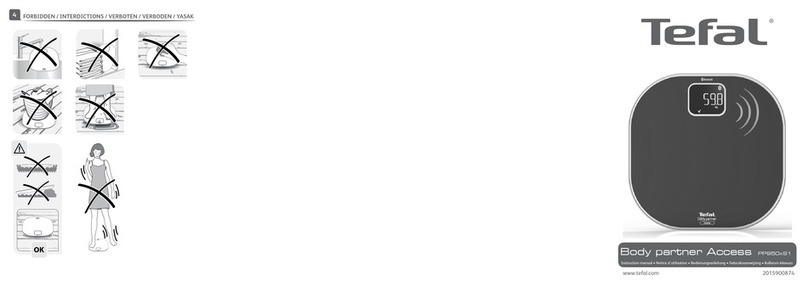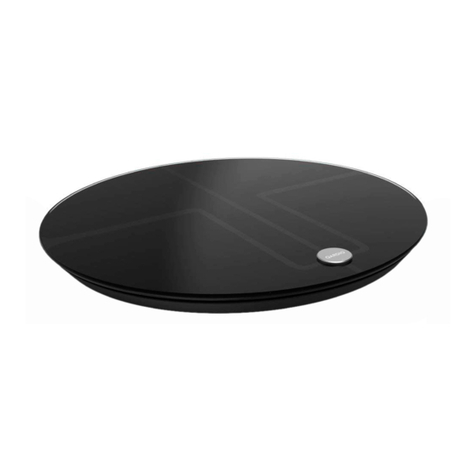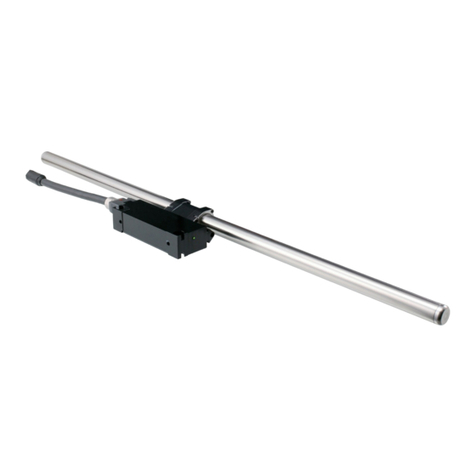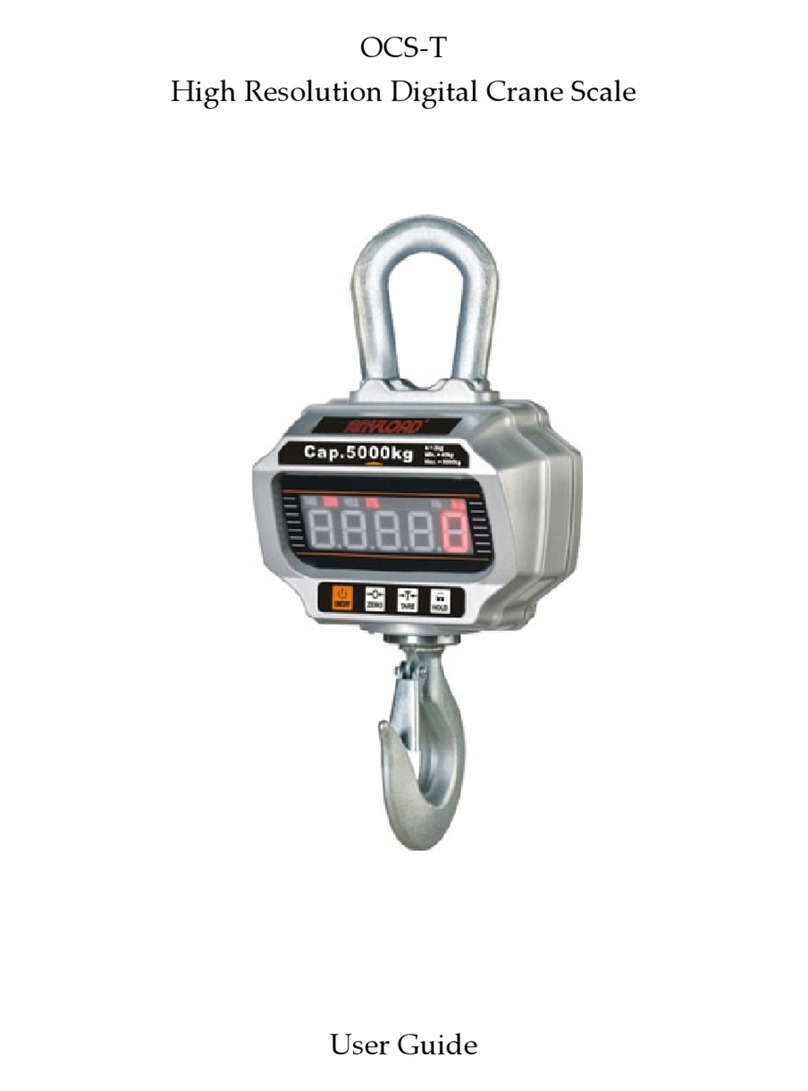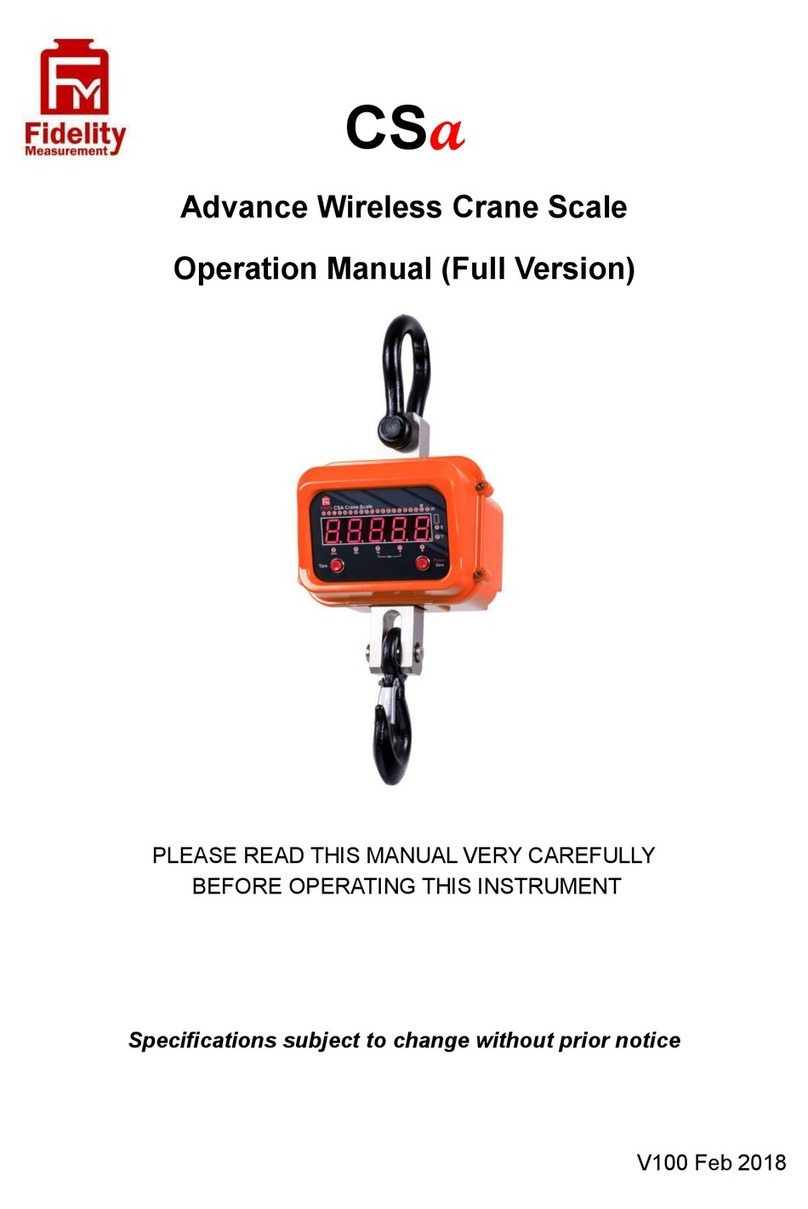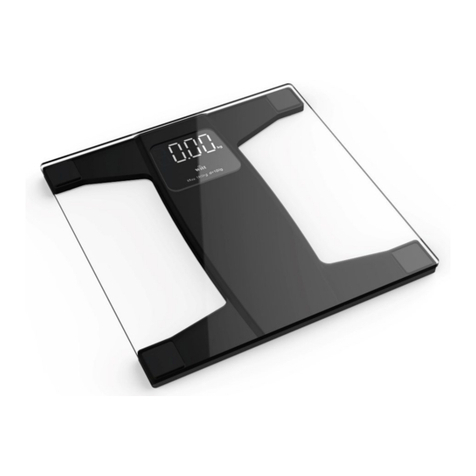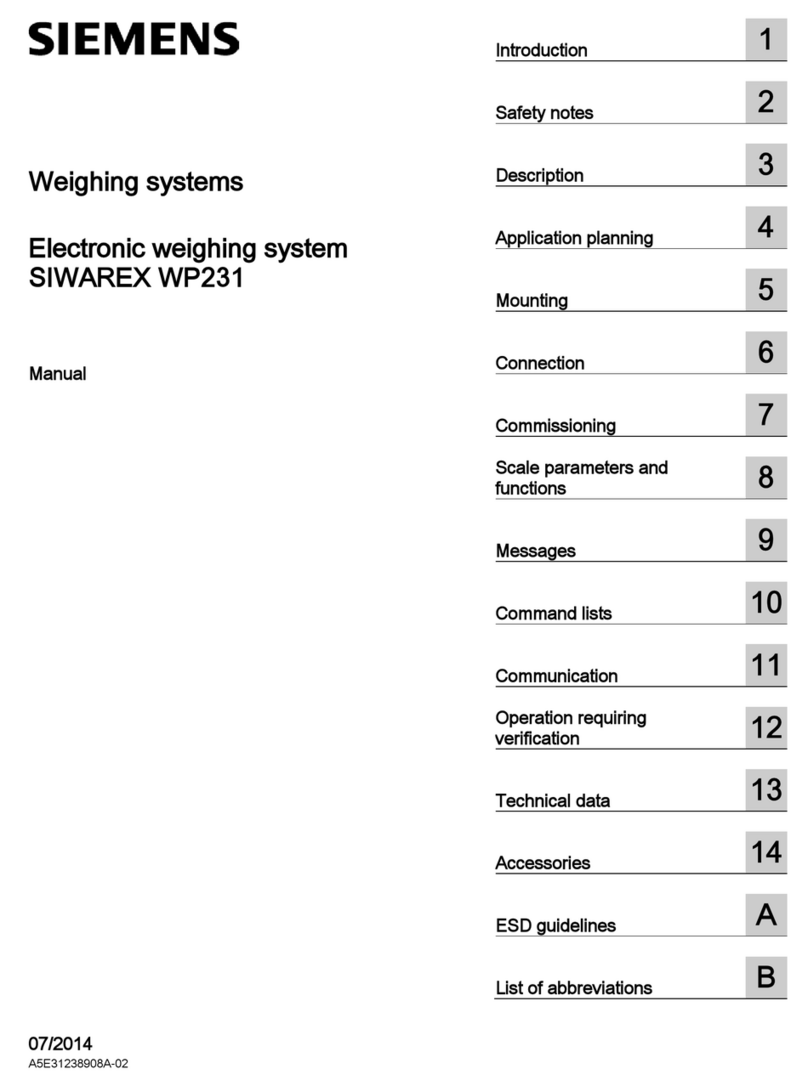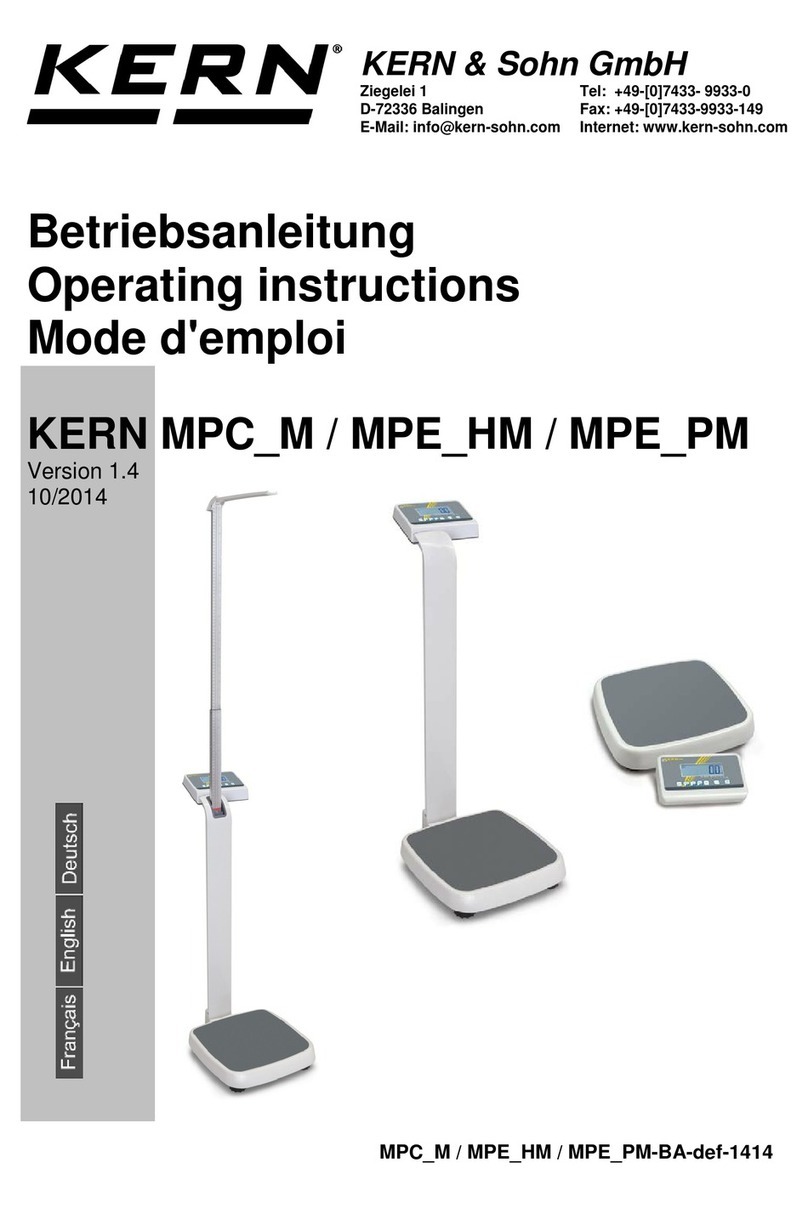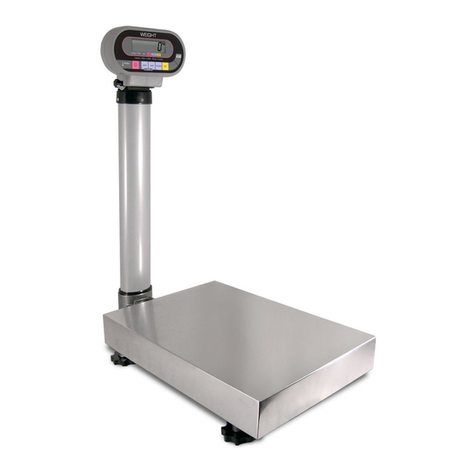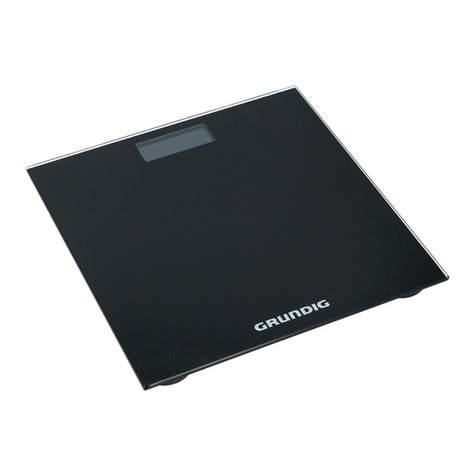thinner TH178WC User manual

SERVICE CENTRE:
©2011 CONAIR CONSUMER PRODUCTS INC.
100 Conair Parkway
Woodbridge, Ontario L4H 0L2
Made in China
For more information on any Conair product call:
1-800-472-7606
Visit our website: www.conaircanada.ca
Consumer Call Centre E-mail:
Consumer_Canada@Conair.com
10CN119516
1-800-472-7606
www.conaircanada.ca IB-10544
Glass Body Analysis Scale
Instruction Booklet
Please read instructions before using your scale.
Model TH178WC
Have a Question?
Please do not return this product to the retailer.
Call Us First!
Our customer service and product experts
are ready to answer ALL your questions.
Please call our TOLL-FREE customer service number at:
1-800-472-7606 or visit us online at
www.conaircanada.ca
LIMITED TEN YEAR WARRANTY
Conair will repair or replace, at our option, your appliance free of charge for 120
months from the date of purchase if the appliance is defective in workmanship or
materials.
To obtain service under this warranty, return the defective product to the service
center listed below that is nearest you, together with your sales slip and $7.00 for
postage and handling.
ANY IMPLIED WARRANTIES, OBLIGATIONS, OR LIABILITIES, INCLUDING BUT NOT
LIMITED TO THE IMPLIED WARRANTY OF MERCHANTABILITY AND FITNESS FOR
A PARTICULAR PURPOSE, SHALL BE LIMITED IN DURATION TO THE 120-MONTH
DURATION OF THIS WARRANTY.
IN NO EVENT SHALL CONAIR BE LIABLE FOR ANY SPECIAL, INCIDENTAL, OR
CONSEQUENTIAL DAMAGES FOR BREACH OF THIS OR ANY OTHER WARRANTY,
EXPRESS OR IMPLIED, WHATSOEVER. This warranty gives you specific legal rights,
and you may also have other rights which vary from province to province.

Customizing Your Body Analysis Monitor
This scale can be customized for up to 4 users. While the customization process is
not difficult, it may be easiest to read all the instructions first to familiarize yourself
with them. Then keep the instruction manual handy as you go through the process
step by step.
Buttons: USER, SET, Up and Down arrows
1. To set your user data
Tap the scale to turn it on and wait until "0.0" appears.
2. Setting the user number
Press the “Set “button. The number “P-01” will appear and blink. Use the Up/Down
button to select a user number (P-01 to P-4). Press SET to confirm.
3. Setting the height
Next, the inch or cm symbol light up (if switch is set to lb, default is height in inches;
if switch is set to KG, default is height in cm). Press the up or down arrows to adjust
the height. Pressing and holding either the up or the down arrow will advance
numbers quickly. Press SET to accept the height. Scale enters the age setting mode.
4. Setting the age
“AGE” appears and the default age 25 flashes. Press the up or down arrows to
adjust the age and press SET to confirm. The scale enters the gender setting mode.
5. Setting the gender
A gender icon flashes. Press the up or down arrows to choose between male and
female gender.
6. Displaying and storing data
Once gender is set, data storage is complete. Scale will display your stored data:
User number, Height and Age will each show for a few seconds.
7. The scale will turn off automatically. It is now ready for use.
Body Analysis
1. Operate the scale on a secure flat floor. Tap the scale to turn it on, and wait till
“0.0” appears. Press the “User” button repeatedly until your user number shows on
the display.
2. Stored data for your user number appears (User number, Height, and Age) then
the scale displays “0.0”.
3. Step on the scale barefoot with your feet aligned on the electrodes (metal strips)
on both the sides of platform. Note: you must be barefoot in order for the scale to
read your body analysis measurements.
4. Your current weight will be displayed for a few seconds.
5. Next, the display will show your body fat weight.
6. Then the display will show your body fat percentage.
7. Next, the display shows your body water percentage.
8. Then, the display shows your bone mass value.
9. Finally, the display shows your Body Mass Index (BMI) score.
kg
F A T

10. Display turns off automatically.
NOTES
If you step on the scale before “0.0” appears, the scale will not
function properly.
Scale will show “Err” if there is improper foot contact in the body
analysis mode, for instance, when you stand on the scale with
socks or shoes on. Hard or dry skin can prevent you making
proper contact with electrodes on the surface of the scale. Try
applying a small amount of moisturizer to your feet before using
the scale.
Weight and Body Fat
How does it work?
While body fat can be measured in many ways, the method used in your scale is
bioelectrical impedance. This indirect method of determining body fat starts when a
safe and very low electrical current is sent through the lower half of the body.
The electrical current flows more quickly through water and muscle than it will
through bone and fat. The scale measures the speed of the current. Based on this
number, the scale estimates body fat using a multi-step, mathematical formula.
Is it accurate?
Measurements of body fat tend to fluctuate a lot more than simple weighing, and
different methods of estimating body fat yield very different results. Just as different
scales give different results, different body fat analyzers can provide very different
body fat estimates. Even with the same scale the numbers will vary because:
• Weight loss tends to produce substantial, continuous, and unpredictable changes
in body water content. Because body fat analysis is determined by water content
in the body, results can vary considerably from day to day.
• Hydration status affects body fat results. If you’ve just worked out, there is less
water for the electrical current to flow through. This may result in a higher body fat
result. In the same way, if you measure your body fat after drinking a lot of fluid, it
may appear that body fat is lower than it really is.
• Skin temperature can have an influence also. Measuring body fat in warm humid
weather when skin is moist will yield a different result than if skin is cold and dry.
• As with weight, when your goal is to change body composition it is better to track
trends over time than to use individual daily results.
• Results may not be accurate for persons under the age of 16, or persons with an
elevated body temperature, diabetes or other health conditions.
What you need to know!
• Percent body fat refers to the number of pounds of fat divided by your total body
weight and multiplied by 100.
• During weight loss, percent body fat doesn’t appear to be reduced as quickly as
expected because total weight loss and total body fat are decreasing at the same
time (for a more detailed explanation, see next section).
• Weight loss in the form of body fat and lean tissue (muscle) is common,
and is normal.
• To minimize the loss of lean tissue, include regular physical activity,
especially strength training, in your weight-loss plan.
Why do I lose weight but my body fat percentage doesn’t change much?
Most body fat monitors show body fat as a percentage only. This body fat monitor
shows you not only a percentage but the actual number of body fat pounds (in fact,
this is the measurement you see after your weight is displayed).
Why is that important? When you lose weight, both the numerator (pounds of body
fat) and denominator (total body weight) go down, so when it’s calculated as a body
fat percentage, the number can be small. For example, a person may weigh 200
pounds and have 40% body fat (= 80 pounds of body fat). He/She loses 20 pounds,
but the body fat has only dropped 4% to 36%. That 4% of body fat was 16 pounds
of fat – a very significant amount! So do not be overly concerned if you do not see
the percentage change quickly as you are losing weight: monitor the absolute num-
ber of body fat pounds lost. Remember, to minimize the loss of lean tissue, include
regular physical activity, especially strength training, in your weight-loss plan.
BMI – What Is It?
BMI stands for Body Mass Index, a statistical term derived from height and weight.
It is closely linked to body fat and health outcomes. Over 50 organizations, includ-
ing the US Government and the World Health Organization, have adopted BMI
guidelines. BMI is inversely related to fitness, meaning that the higher your BMI,
the less likely you are to be fit. Every time your body analysis monitor reads your
weight and calculates your body fat, it also calculates your BMI. Along with your
weight and your body fat measurements, the BMI reading gives you yet one more
tool to monitor your health and fitness.
Body Water/Hydration Levels
General health standards indicate that one should consume approximately 64 oz
of water per day from food and liquids to maintain a healthy level of hydration.
Maintaining a good hydration level will help improve your overall health and general
feeling of well-being. If your hydration levels are lower than average, you should
increase your water intake accordingly.
Body water/hydration level – how is it measured?
The hydration level is measured by using Bioelectric Impedance Analysis (BIA).
The same analysis that is used to calculate your body fat is used to calculate your
hydration level. Taking into consideration a user’s age and gender, a calculation is
made that determines the percentage of water.
Please note: It is not recommended to take the hydration measurements in cer-
tain situations, such as following exercise, after drinking a glass of water, or directly
prior to, during or shortly after menstrual cycles. Hydration may not be at normal
levels during these times.
Bone Mass – What Is It?

Bone is a living, growing tissue. During youth, your body makes new bone tis-
sue faster than it breaks down older bone. In young adulthood, bone mass is at
its peak; after that, bone loss starts to outpace bone growth, and bone mass
decreases. But it’s a long and very slow process that can be slowed down even
more through calcium-rich diets and weight-bearing exercise.
Who should monitor bone mass?
Most people have no need to monitor bone mass, but certain groups – post-
menopausal women, men and women with certain diseases, and anyone who
takes medications that affect bone tissue – might want to watch for decreases in
bone mass. The bone mass reading is to be used as guide only. Watch for trends
over time and contact your healthcare provider for a more detailed explanation of
the readings and with any questions or concerns.
Make the most of it!
To summarize, make the most of the body analysis feature by:
• Tracking change over time and not day to day.
• Using the same scale as much as possible.
• Being extra-consistent in the time of day, day of the week, time before or after food
and fluid consumption, before or after exercise, etc., when measuring body com-
position.
Body Analysis Table
Always keep in mind that you know your body best. The following ranges of body
fat, BMI, body water and bone mass are offered as guides.
low on target high
BMI <20 20-25 25+
Body Fat
age % % %
Male 20-29 <13% 13-23% 23.1%+
30-39 <14 14-24 24.1+
40-49 <15 15-25 25.1+
50-59 <16 16-26 26.1+
60-69 <17 17-27 27.1+
Female 20-29 <18 18-28 28.1+
30-39 <19 19-29 29.1+
40-49 <20 20-30 30.1+
50-59 <21 21-31 31.1+
60-69 <22 22-32 32.1+
Body Water
age % % %
Male 20-69 <50% 50-65% 65%+
Female 20-69 <45 45-60 60+
Bone Mass
age % % %
Male 20-29 <7.6% 7.6-8.4% 8.5%+
30-39 <7.4 7.4-8.2 8.3+
40-49 <7.0 7-7.8 7.9+
50-59 <6.6 6.6-7.4 7.5+
60-69 <6.3 6.3-7.1 7.2+
Female 20-29 <6.2% 6.2-7% 7.1%+
30-39 <6.0 6-6.8 6.9+
40-49 <5.6 5.6-6.4 6.5+
50-59 <5.2 5.2-6 6.1+
60-69 <4.9 4.9-5.7 5.8+
Important Information Concerning
Weight Management
Your scale is the best tool for monitoring weight. While not the only measure of
weight loss, scales are the most popular method used to gauge weight-loss suc-
cess. A scale measures the sum of your total body weight, which includes bone,
muscle, fat, and water.
Body weight fluctuates during the day, and from day to day,
depending on a variety of factors.
• Salt and carbohydrate intake can affect the body’s water retention.
• A large meal adds weight and can cause water retention.
• Dehydration from exercise, illness, or low fluid intake can result in
weight loss.
• Muscle is also a factor. Heavy-duty resistance training can build muscle, which
can affect weight.
• The menstrual cycle can cause temporary weight gains and losses.
When You’re Losing Weight
It’s important not to put too much stock in the exact number on the scale, because
it can and will vary. This is especially true when you’re dieting. Small weight gains
and losses are common as your body adjusts to fewer calories and more exercise.
Your scale is a valuable tool when used to track weight over a period of weeks and
months. Be aware that different scales often give different results. The scale at your
doctor’s office may show one weight, and your scale at home another. So don’t
get too caught up with a single number.
Don’t Overdo It!
A surefire way to get overly concerned with your weight is to weigh yourself too
often. We generally recommend weighing yourself no more than once a week
when you’re dieting. Though it’s hard to stick to this pattern, it’s the best way to
prevent unnecessary concern with normal weight fluctuations, which are unrelated

to your weight-loss efforts. Regardless of your weighing habits, it’s important that
you’re consistent.
Here are 5 rules for effectively monitoring your weight – weigh yourself:
To keep track of your weight, record only one number for the week. This
will give you a clear picture of any trend your weight is following.
When You’re Maintaining Weight
Fluctuations in day-to-day weight tend to be smaller when weight is stable, so a
more frequent weigh-in pattern is helpful. To maintain a stable weight:
• Weigh yourself more often than once a week.
• Use the “5-pound rule” – research shows that people who keep weight within a
5-pound range are more likely to maintain a healthy body weight over the long
term.
Facts You Should Know
Your Weight Watchers scale is a precise measuring instrument that is most accu-
rate when weighing a stationary object. To ensure accurate readings, always try
to stand on the same area of the scale platform and DO NOT MOVE. Should the
weight on the scale exceed the scale’s capacity, you may see an error message
”ERR”.
Electronic sensors are sensitive. Be careful not to drop or jar the scale.
Place it gently onto floor surface, and store where it will be protected from impact.
The scale is an electronic instrument and should never be submerged in water.
Clean with damp cloth and/or glass cleaner.
In the event that the scale batteries needs to be replaced, (display shows “Lo”),
open the battery cover on the bottom of the scale and replace the old batteries
with two new 3V lithium batteries. Dispose of the old batteries properly.
Do not attempt to open the scale or to remove any components.
Servicing should be done by qualified technicians only. See warranty infor-
mation below.
Before Using Scale
Precautions for Use
CAUTION! Use of this device by persons with any electrical implant such as a
heart pacemaker, or by pregnant women, is not recommended.
Please consult your physician should you have any questions about the use
of this product in relation to any condition you may have, or treatment you
may be receiving.
1. Set switch on the base of the scale to measure in pounds (lb) or kilograms (kg).
2. Set scale on floor. Surface must be level for accurate operation and safety.
Using the Weight Only Mode
Instructions for customizing your Weight Watchers Body Analysis scale are below.
However, the scale does not need to be programmed to operate as a simple weigh
scale.
1. Tap the scale with your foot to turn it on. The display will light up.
2. Wait until all digits light for several seconds and “0.0” appears.
3. Step on the scale and stand still to measure your weight.
4. The weight reading stays lit for several seconds. Then the scale will shut off
automatically.
• Once a week, on the same day
of the week
• At the same time of day
• In the same place
• Wearing the same clothes
• Using the same scale
Table of contents
Other thinner Scale manuals
